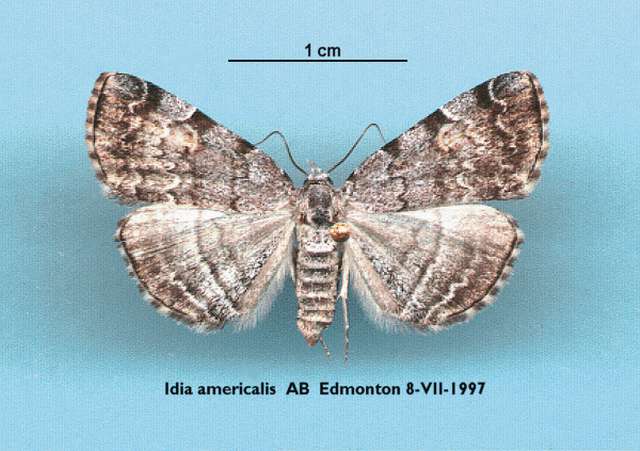Species Details
Idia americalis
University of Alberta E.H. Strickland Entomological Museum Read more about this collection »
Common NameAmerican Snout or Snout-moth, American Idia
SeasonalityAdults are on the wing from the latter half of May through mid September.
IdentificationA small (2-3 cm. wingspan), broad-winged and rather delicate moth. The forewings are light blue-grey and brown, marked with fine black jagged cross lines. The lines thicken where they meet the costa, forming a series of three prominent black spots. The reniform spot is usually filled with yellowish or orange scales. Three parallel lines partially cross the hindwings. Specimens from cooler and more mesic environments in the mountains and northern areas may be dusky and have the makings "blurred". Specimens from the more xeric areas of the southern boreal forest south tend to be larger, paler, and more crisply marked. Both sexes are similar. They may be mistaken for a small geometrid moth.
Scientific Name
Idia americalis
Common Name
American Snout or Snout-moth, American Idia
Habitat
Wooded areas.
Seasonality
Adults are on the wing from the latter half of May through mid September.
Identification
A small (2-3 cm. wingspan), broad-winged and rather delicate moth. The forewings are light blue-grey and brown, marked with fine black jagged cross lines. The lines thicken where they meet the costa, forming a series…
A small (2-3 cm. wingspan), broad-winged and rather delicate moth. The forewings are light blue-grey and brown, marked with fine black jagged cross lines. The lines thicken where they meet the costa, forming a series of three prominent black spots. The reniform spot is usually filled with yellowish or orange scales. Three parallel lines partially cross the hindwings. Specimens from cooler and more mesic environments in the mountains and northern areas may be dusky and have the makings "blurred". Specimens from the more xeric areas of the southern boreal forest south tend to be larger, paler, and more crisply marked. Both sexes are similar. They may be mistaken for a small geometrid moth.
Life History
Adults are noctural and come readily to light as well as to sugar bait. The adult flight period is unusually extended, from spring through fall. They either emerges continuously or in several overlapping broods.
Conservation
A common, widespread species; no concerns.
Diet Info
No Alberta data. Elsewhere larvae are reported to feed on fungus, dead (molding?) leaves and other detritus, often in ant or bird's nests.
Range
Throughout much of North America, from Florida to Vancouver Island. In Alberta it is found from the wooded valleys of the plains (Milk River valley) to the northern border (Zama and the north shore of Lake…
Throughout much of North America, from Florida to Vancouver Island. In Alberta it is found from the wooded valleys of the plains (Milk River valley) to the northern border (Zama and the north shore of Lake Athabasca), and especially common in the Aspen parklands and southern Boreal forest regions.
References
Author
Covell, C. V., Jr.
Title
A field guide to the moths of eastern North America.
Publication Date
1984
Pages
496
Author
Handfield, L.
Title
Le guide des papillons du Quebec.
Publication Date
1999
Pages
536
Specimen Information
There are 300 specimens of this Species.
BIRD4985 - Idia americalis
University of Alberta E.H. Strickland Entomological Museum
Place CollectedCanada: Alberta, Erskine
Collected ByBird, C. D.
Date Collected2000-07-11
BIRD4986 - Idia americalis
University of Alberta E.H. Strickland Entomological Museum
Place CollectedCanada: Alberta, Erskine
Collected ByBird, C. D.
Date Collected2000-07-11
BIRD4987 - Idia americalis
University of Alberta E.H. Strickland Entomological Museum
Place CollectedCanada: Alberta, Erskine
Collected ByBird, C. D.
Date Collected2000-07-12
BIRD4988 - Idia americalis
University of Alberta E.H. Strickland Entomological Museum
Place CollectedCanada: Alberta, Erskine
Collected ByBird, C. D.
Date Collected2000-07-12
BIRD4989 - Idia americalis
University of Alberta E.H. Strickland Entomological Museum
Place CollectedCanada: Alberta, Erskine
Collected ByBird, C. D.
Date Collected2000-07-12
BIRD4990 - Idia americalis
University of Alberta E.H. Strickland Entomological Museum
Place CollectedCanada: Alberta, McKenzie Crossing
Collected ByBird, C. D.
Date Collected2000-07-16
BIRD4991 - Idia americalis
University of Alberta E.H. Strickland Entomological Museum
Place CollectedCanada: Alberta, McKenzie Crossing
Collected ByBird, C. D.
Date Collected2000-07-16
BIRD4992 - Idia americalis
University of Alberta E.H. Strickland Entomological Museum
Place CollectedCanada: Alberta, McKenzie Crossing
Collected ByBird, C. D.
Date Collected2000-07-16
BIRD4993 - Idia americalis
University of Alberta E.H. Strickland Entomological Museum
Place CollectedCanada: Alberta, McKenzie Crossing
Collected ByBird, C. D.
Date Collected2000-07-16
BIRD4994 - Idia americalis
University of Alberta E.H. Strickland Entomological Museum
Place CollectedCanada: Alberta, McKenzie Crossing
Collected ByBird, C. D.
Date Collected2000-07-06
BIRD4995 - Idia americalis
University of Alberta E.H. Strickland Entomological Museum
Place CollectedCanada: Alberta, McKenzie Crossing
Collected ByBird, C. D.
Date Collected2000-07-16
BIRD4996 - Idia americalis
University of Alberta E.H. Strickland Entomological Museum
Place CollectedCanada: Alberta, McKenzie Crossing
Collected ByBird, C. D.
Date Collected2000-07-16
BIRD4997 - Idia americalis
University of Alberta E.H. Strickland Entomological Museum
Place CollectedCanada: Alberta, Winfield
Collected ByBird, C. D.
Date Collected2000-07-22
BIRD4998 - Idia americalis
University of Alberta E.H. Strickland Entomological Museum
Place CollectedCanada: Alberta, Erskine
Collected ByBird, C. D.
Date Collected2000-07-24
BIRD4999 - Idia americalis
University of Alberta E.H. Strickland Entomological Museum
Place CollectedCanada: Alberta, Erskine
Collected ByBird, C. D.
Date Collected2000-07-24
BIRD5000 - Idia americalis
University of Alberta E.H. Strickland Entomological Museum
Place CollectedCanada: Alberta, Erskine
Collected ByBird, C. D.
Date Collected2000-07-24
BIRD5001 - Idia americalis
University of Alberta E.H. Strickland Entomological Museum
Place CollectedCanada: Alberta, Erskine
Collected ByBird, C. D.
Date Collected2000-07-24
BIRD5002 - Idia americalis
University of Alberta E.H. Strickland Entomological Museum
Place CollectedCanada: Alberta, Erskine
Collected ByBird, C. D.
Date Collected2000-07-24
BIRD5003 - Idia americalis
University of Alberta E.H. Strickland Entomological Museum
Place CollectedCanada: Alberta, Winfield
Collected ByBird, C. D.
Date Collected2000-07-28
BIRD5004 - Idia americalis
University of Alberta E.H. Strickland Entomological Museum
Place CollectedCanada: Alberta, Winfield
Collected ByBird, C. D.
Date Collected2000-07-28
BIRD5005 - Idia americalis
University of Alberta E.H. Strickland Entomological Museum
Place CollectedCanada: Alberta, Winfield
Collected ByBird, C. D.
Date Collected2000-07-29
